November 27, 2007 at 11:15 pm · Filed under Uncategorized
Our quest to understand Hawaii continues. This morning on our drive south the first revelation was that Hawaii’s “homeless problem” is much more vast and complex than we had first thought. The cities of tents extend for intermittently for about sixteen miles along the leeward Wai’anae shore.
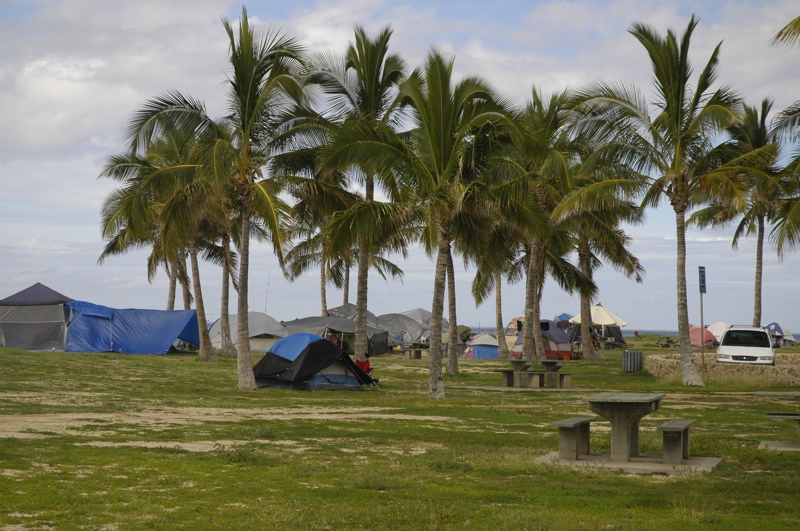 Our initial impression was that these were beach bums, drop-outs, and surfers who were only taking advantage of a cheap lifestyle, but upon a closer look it has become clear that families are living there. There are children and old people, people who live in dirty clothes and a few who drive expensive cars.
Our initial impression was that these were beach bums, drop-outs, and surfers who were only taking advantage of a cheap lifestyle, but upon a closer look it has become clear that families are living there. There are children and old people, people who live in dirty clothes and a few who drive expensive cars.
They have taken over miles of beach and half a dozen state parks. There are hundreds of tents and perhaps a couple thousand people — and the number is growing. It is the largest encampment of homeless people we have ever seen in the United States. The western shore of Oahu is a little slice of the third world, right here in our country, just 30 miles from some of the wealthiest people in the world blithely enjoying Waikiki Beach.
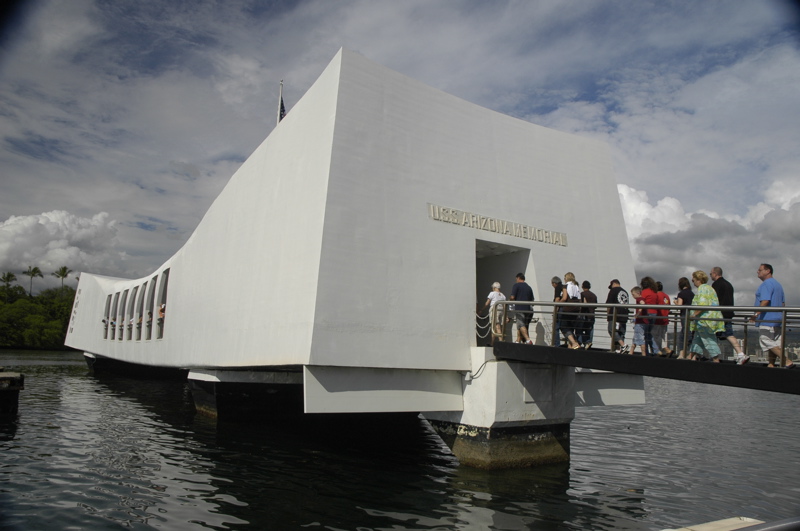
Another angle on Hawaii is found at Pearl Harbor, where the USS Arizona lies on the bottom and WW II history is echoed in the monument, the neighboring Pacific Aviation Museum, the USS Missouri floating nearby, the submarine Bowfin, and a circle of plaques that commemorate the heroics of submariners.
The Arizona monument is right up there with the Vietnam Memorial in Washington DC for sheer chilling power combined with historical education. I highly recommend it to all, despite the 1-hour plus waits required to see the monument. (You have to be taken out to the site by Navy launch.) The museum, brochure, and movie all do an excellent job at explaining the events leading up to Pearl Harbor and our involvement in World War II.
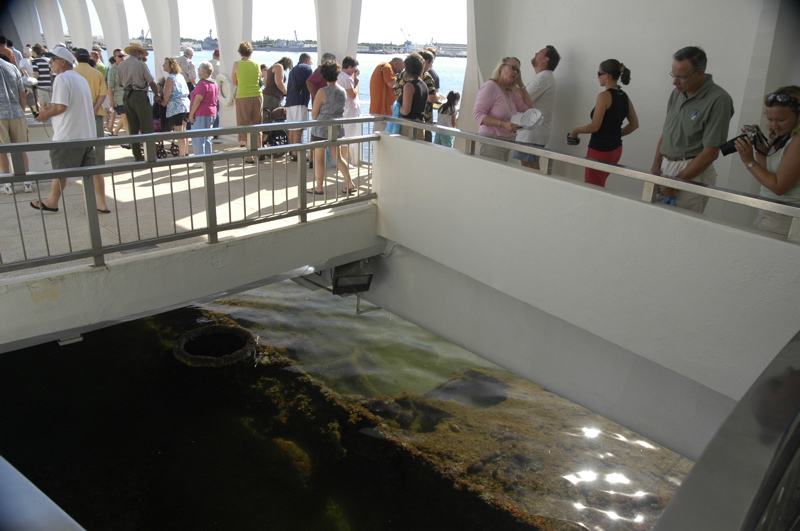
So by the time you get to the monument, standing solemnly over the gravesite of 900 Navy servicemen, and see the “black tears” of oil floating to the surface from the encrusted wreck of the USS Arizona, it all comes together. As much as the long-ago volcano that built the island, the events of Pearl Harbor formed the Hawaii we know today.
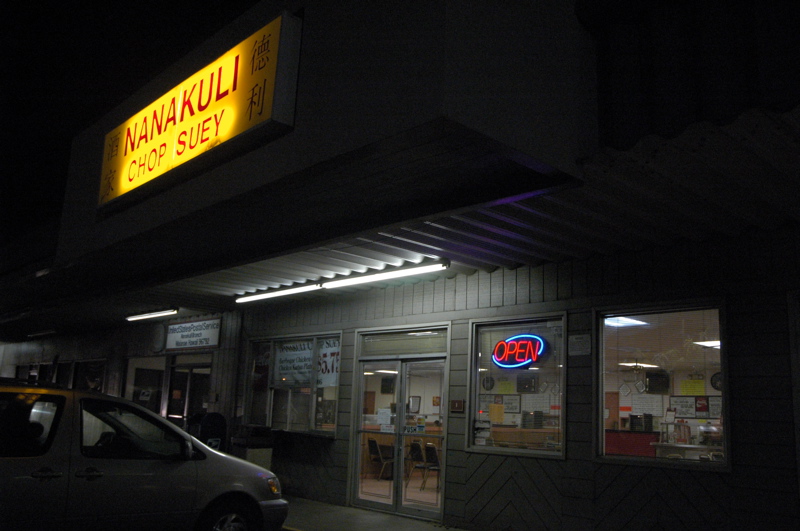 Our final lesson on Hawaii comes from the food. Go to a lu’au and you’ll get some traditional Hawaiian foods like poi, and a lot of other modern favorites like pork ribs. In the fancier restaurants you’ll find “Asian fusion” and “Pacific Rim” cuisine. But today’s Hawaii has a people’s cuisine that the fancy resorts won’t acknowledge. Here on the cheap side of the island there are several “chop suey” restaurants, and in our quest we felt obligated to give them a try. Clearly they are popular with the locals.
Our final lesson on Hawaii comes from the food. Go to a lu’au and you’ll get some traditional Hawaiian foods like poi, and a lot of other modern favorites like pork ribs. In the fancier restaurants you’ll find “Asian fusion” and “Pacific Rim” cuisine. But today’s Hawaii has a people’s cuisine that the fancy resorts won’t acknowledge. Here on the cheap side of the island there are several “chop suey” restaurants, and in our quest we felt obligated to give them a try. Clearly they are popular with the locals.
It turned out to be a good gamble. We ordered a few simple dishes: wonton soup, noodles with shrimp, etc., and were rewarded with an enormous amount of delicious food for dinner in our hotel room. This may be the best deal on the leeward side.
Add to the chop suey another Hawaiian favorite: shave ice. On the North Shore in the town of Haleiwa is the best shave ice we’ve ever had. For a buck twenty-five you get a huge cone of ice drenched with three different flavors of sweet syrup. This is not a 7-11 Slurpee or one of those lame “snow cone” things sold on the mainland. This is a really incredible sensation of frozen nectar, and just the right thing for a humid Hawaiian afternoon. Perhaps if we keep ingesting these things we’ll come to understand Hawaii even better. It’s worth a try.
November 26, 2007 at 11:40 am · Filed under Places to go
At 3:10 a.m. last night a strange dream startled me awake. I noticed that the entry light in the hotel room was left on, so I got up to turn it off and stepped into a puddle of water. Water was dripping from the illuminated ceiling light onto the tile floor.
My laptop was sitting on the floor just a few feet from this event, being recharged at the only available plug in the room, and it was splashed with water, but fortunately only on the top. The keyboard and the rest of the case were dry. I rescued it and grabbed the ice bucket to catch the dripping water, and then called the hotel’s Front Desk.
By 3:30 or so the Mystery of the Dripping Light Fixture was solved: the central air conditioning unit’s drain had apparently failed and the ceiling above our entryway was flooded. We shut off the A/C, laid out some towels, and went back to bed.
That is, until 5 a.m. when Emma awoke us to announce that the front right bicuspid that had been bothering her for the past week had finally come out. Eleanor decided that the tooth fairy was already on her way home for the evening, and it was agreed that the tooth would have to wait for the next night.
So it wasn’t a highly restful night. At 8 a.m. we got up and began packing up the room to move to another room. Between packing, waiting for housekeeping to get another room ready, and unpacking, we lost most of the morning. I would like to say that the hotel was exemplary about this situation, but they weren’t. The Front Desk staff was unapologetic and we ended up in an identical room with no offer of an upgrade or any conciliatory action for the wasted morning.
But this is not highly surprising. The hotel is tired. Basic maintenance is done but the little signs of long-term decay are everywhere here. The beds are saggy, the drawers are malfunctioning, the carpets are overdue for replacement, the bathroom hot water tap doesn’t reliably shut off, the A/C thermostat doesn’t work, and a couple of fluorescent bulbs never would light fully. On the surface the hotel appears nice enough, with very nice landscaping and a spectacular setting with panoramic views, but at its core it is a grade B tourist hotel with decaying infrastructure.
[Followup 11-29-2007]: [On checkout Eleanor spoke to the new hotel manager about the problems we had. He listened, was sympathetic, and spoke honestly about the problems the hotel has. He’s been trying to turn the place around since he took over four months ago. By way of apology he comp’d one of our meals and spent about fifteen minutes with Eleanor discussing what he plans to do to improve things. We were reasonably impressed and hope that in the future the hotel will do better under his good leadership.]
This gave me occasion to compare disappointing places we’ve encountered with the Airstream to this experience. We’ve had some really bad campgrounds, but since we tow our “hotel room” around with us, at least we have control of our immediate surroundings, and since they are mobile we can easily move to a better location as needed. We also maintain our Airstream better than this hotel does its rooms.
Since we usually don’t spend much time in a hotel room, it’s not normally something we think about. Today would have been same if we had been able to get up and go out for the day as we were expecting. Only the fact that we were trapped here most of the morning has forced us to look at the room and the hotel more critically, and see the faults of the place.
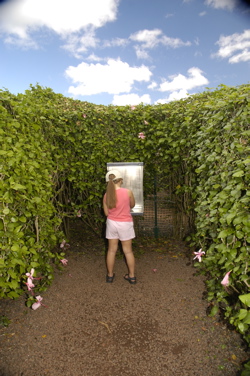 With less than a full day to play with, we opted to do tourist things rather than go for a full day of snorkeling. On the way to the North Shore we stopped at the Dole Plantation and ran through the World’s Largest Maze to find eight secret stations. This was undoubtedly Emma’s favorite part of the day, although the pineapple sherbert was probably right up there.
With less than a full day to play with, we opted to do tourist things rather than go for a full day of snorkeling. On the way to the North Shore we stopped at the Dole Plantation and ran through the World’s Largest Maze to find eight secret stations. This was undoubtedly Emma’s favorite part of the day, although the pineapple sherbert was probably right up there.
The North Shore is a great part of Oahu. It’s known for big surf, especially in winter, but we found a couple of very nice sheltered snorkeling spots too. Right now a big surfing competition is going on, at least on days when the surf is high.
A right turn off the main road leads up a switchback road to the most intact heiau in Hawaii. It’s now a state monument, called Pu’u O Mahuka Heiau. The heiau is a historic and religious site, and you have to treat it with respect. Because the visible site at first appears to be just a bunch of lava rocks in a field, it takes a little imagination to appreciate what this site represents.
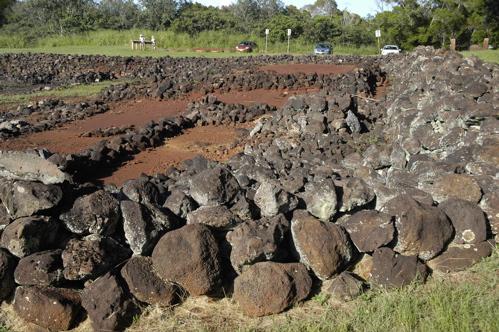
Imagine in the 1800s, you are a British sailor who has landed at Oahu and is going ashore to find fresh water. You and your fellows are captured by the mu, who hauls you up to the stony heiau to face kahuna (high priest) Ka’opulupulu. As part of a ceremony designed to ensure success in war, you are sacrificed at the luakini altar.
Suddenly that pile of rocks is a lot more meaningful, isn’t it? And now, the minor discomforts of a less-than-wonderful hotel aren’t nearly as bothersome. I mean, hey, we’re not being killed here.
The rest of the day (roaming through town, checking out beaches, buying flavored shave ice) was fine, but I’ll always remember the heiau. To me, that’s Hawaii.
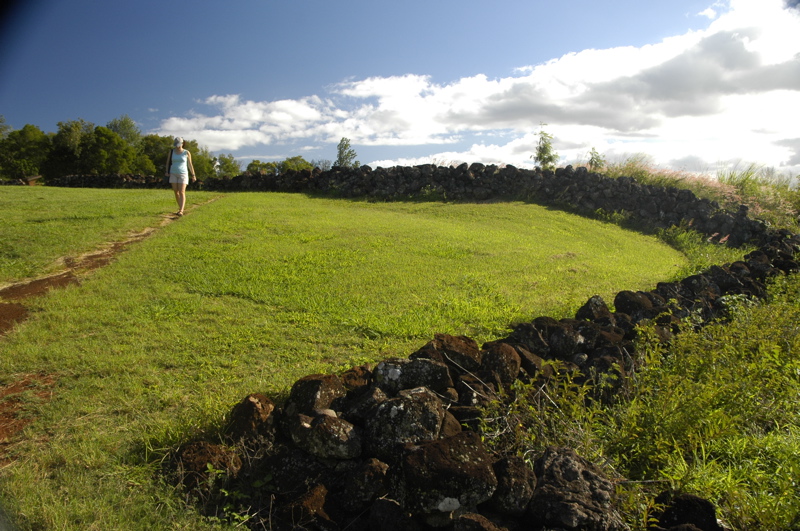
November 25, 2007 at 11:18 am · Filed under Uncategorized
For the next week or so the blog will cover our travels in Hawaii, making it less of an Airstream blog and more about travel in general. But for the aspiring full-time RV’er there’s still relevance. Almost every full-timer I know has broken out of the mold and left the Airstream behind for a period of time, just as you would leave your stationary house behind. There are, sadly, some places Airstreams can’t go.
But although our mode of travel has changed, our style of travel hasn’t. We still prefer to avoid the crowds and programmed adventures in favor of simple and real experiences. In Oahu, this means zipping away from the Waikiki crowds. We’ve taken up residence along the leeward side of the island, a place where people in online forums have reported “there’s not much to do.”
By that they mean that there are no helicopter companies, no parasailing, no museums, no submarines, musicals or dolphin adventures here. All of those things are available in Waikiki and the surrounding area. Here, we have only the basics: wide-open and uncrowded beaches, crystal clear water, snorkeling, hiking, bird songs, and the ruins of a historic site called a heiau. That’s the sort of stuff we came here for, so even though we are on the “tourist resistant” side of the island we should be plenty occupied.
Although we can certainly find a lu’au if we want one, about ten miles down the road. And our hotel is not lacking for niceties either. Breakfast on the patio with a view of the mountains and ocean was just as nice as breakfast will be under the awning in the desert parks we plan to visit later this month.
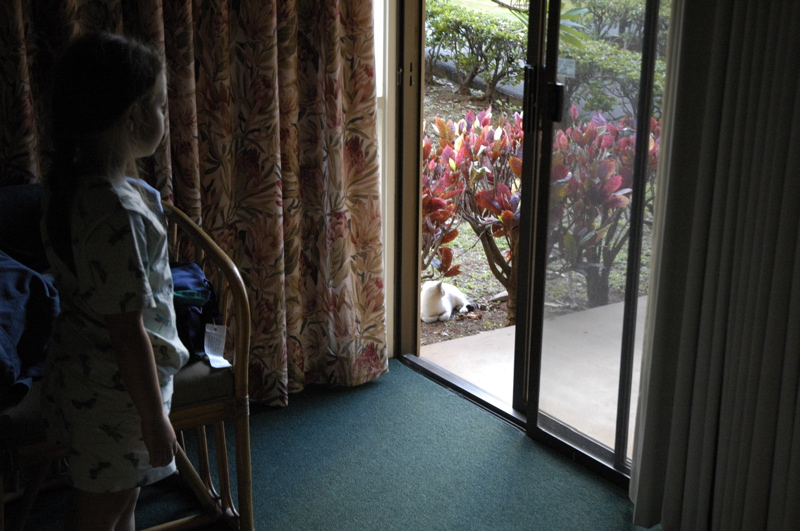
Several times a day we are visited on our lanai by the resident cats of the resort. There are several of them, basically feral but all spayed or neutered by locals who like to see them roaming around. Secret stashes of food around the resort area keep all the cats reasonably plumb. The “fixed” cats are identifiable by a notch on their left ear, and they aren’t too shy about coming into our room for a visit and quick scratch.
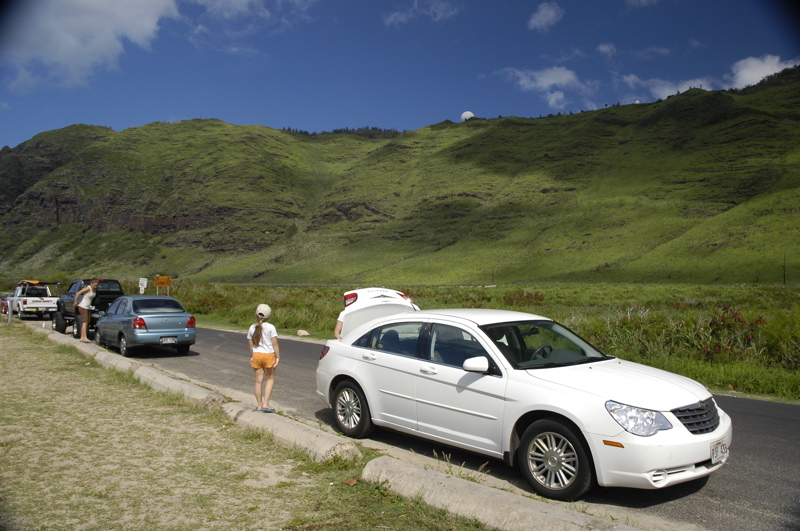 Today our plan was to find a quiet beach and go snorkeling if the surf wasn’t too high. If you follow the road along northward along the leeward side of the island, eventually you’ll come to the last beach, an Air Force Satellite Tracking station and the end of the road. You can see one of the “golf ball” domes of the satellite tracking station in the photo.
Today our plan was to find a quiet beach and go snorkeling if the surf wasn’t too high. If you follow the road along northward along the leeward side of the island, eventually you’ll come to the last beach, an Air Force Satellite Tracking station and the end of the road. You can see one of the “golf ball” domes of the satellite tracking station in the photo.
Even on a nice Sunday there were fewer than 30 people sharing about half a mile of beach with us. The surf was too high for Eleanor and Emma, but I got a little paddling around and saw some colorful reef fish about 150 feet offshore.
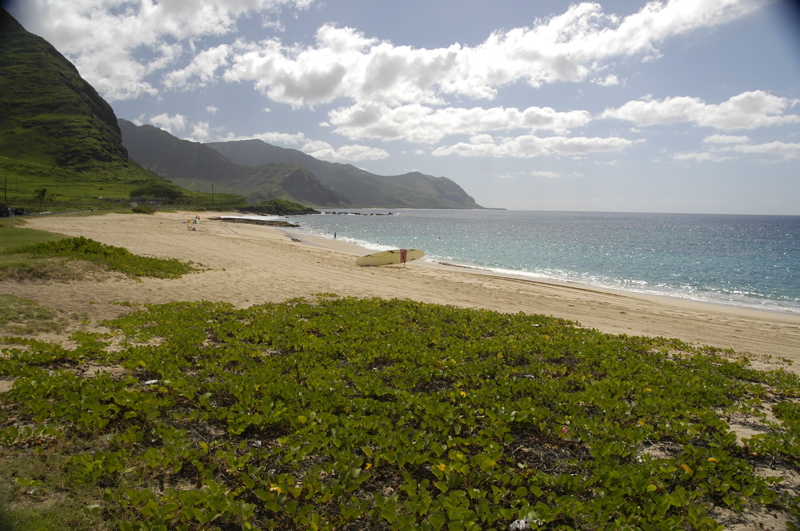
It’s beautiful here, but just south of where this photo was shot, along the leeward side of the island, you see a piece of Hawaii that doesn’t appear in the brochures. It is not a wealthy area. For miles along the roadside you can’t help but notice semi-permanent tent cities erected on the sand. These are the homes of itinerant surfers, drop-outs, and some of the poorer elements of Hawaiian society. Some are so poor they don’t even have tents, but live under blue tarps strung from trees. This is a beautiful stretch of shoreline, but most of it is occupied by people who could never afford to live here if they had to buy or rent a house.
Seeing the diversity of the population makes it apparent that Hawaii is really not just a paradise. In places it is wild, dangerous, even third-world. We’ve seen these bits of Hawaii before, when visiting the Big Island and Maui. There are even sections of those two islands that the Hawaiians have warned us away from because they are roadless and almost lawless.
This might seem frightening and directly opposed to the reason that people come to Hawaii. Most are looking for a resort hotel, some great dinners, a boat ride, a lu’au, a nice beach. Those are all great things but we’re also interested in the real place and the real people. To us, Hawaii is not the equivalent of a cruise ship, but a multi-faceted society with great historical and cultural stories to tell. We’ll be digging into those things a little more this week.
November 24, 2007 at 11:55 am · Filed under Travel / lifestyle musings
This morning I looked out the balcony of our hotel room and saw a billowing line of smoke moving south along the coastline. Malibu is on fire and the smoke extends past LAX. This made me think of our Airstream, which is parked up in the hills north of Los Angeles. Will a wildfire consume the park while we are gone? I can’t imagine anything worse than coming back from our trip to find it a melted puddle of aluminum. It’s still our primary home at this point.
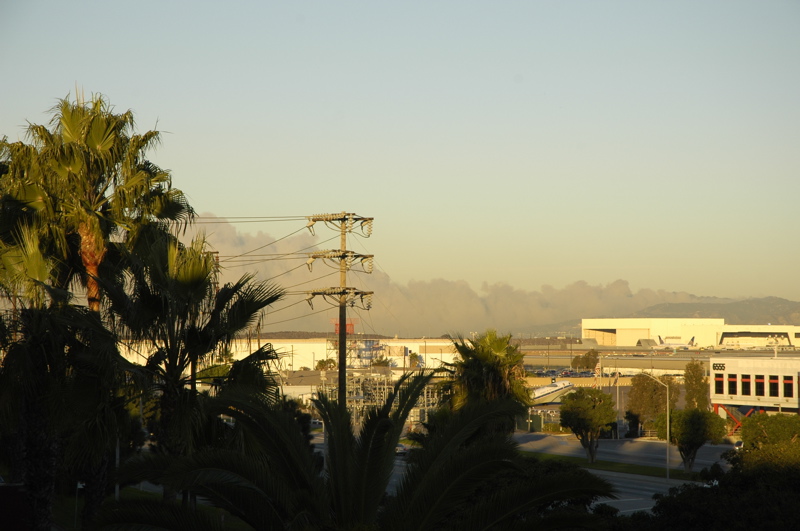
Well, there is nothing I can do about it right now. This morning we could only stare at the news video on the TVs while eating the breakfast buffet at the hotel. With grim images of glowing houses in our heads, we went to the airport.
Long-time readers of this blog know that I have no love for commercial airplane travel anymore. I used to travel a lot via air, for business purposes, but now I am happy to have a job that requires me to travel via the surface of the Earth most of the time. Still, once or twice a year I find myself riding the air bus, either for a family visit or for an overseas destination, and it reminds me of the long string of hassles and annoyances that come with air travel these days.
The overwhelming feeling I get from air travel today is crowdedness. You have to abandon any sense of personal space from the moment you arrive at the airport. This is particularly upsetting to the RV’er I think because we are accustomed to privacy on demand, and a huge amount of freedom in our travels.
The process at the airport seems designed to strip away your individuality and any pretensions you might have that your life is under your control. Start with a line, a long one to check in bags, with unpredictable delays and malfunctioning “self check” machines. Then wait in another line to present your checked bags for scanning, then another line to have your identification compared to your ticket. By the time you reach the final line to be stripped of your shoes, have your pockets emptied, and present your personal toiletries in a see-through bag, you’ve come to accept the system. Fast “institutionalization.”
 So the subsequent wait to shuffle down a line and wrassle for overhead storage bins doesn’t jar you as much as it might have an hour earlier, when you were still free and living outside the institution. I’m amazed that people who don’t travel by RV but who do travel by air tend to ask us how we bear up “crowded together” in the Airstream. I’d rather spend a rainy day in my Airstream with my family than five hours on a Boeing 767-300 ER “¦
So the subsequent wait to shuffle down a line and wrassle for overhead storage bins doesn’t jar you as much as it might have an hour earlier, when you were still free and living outside the institution. I’m amazed that people who don’t travel by RV but who do travel by air tend to ask us how we bear up “crowded together” in the Airstream. I’d rather spend a rainy day in my Airstream with my family than five hours on a Boeing 767-300 ER “¦
“¦ which is where I am at this writing. The “ER” designator means “Extended Range”, and it’s the version that is favored by long-haul carriers for overseas flights. Two big jet engines and an extra-long fuselage means Hawaiian Airlines can cart a whole herd of tourists over the Pacific in complete safety and moderate comfort, albeit with only a few cubic inches of personal space.
Not that I have anything against the Boeing. It’s a remarkable piece of technology and my immense respect for what it represents as an achievement helps temper my feelings about riding inside it. Just seeing the smooth fuselage gives me an awestruck feeling. I can’t help think about where it has been. Yesterday perhaps one of the jets might have been in Paris, this morning parked at Dallas, and in ten hours it might go back to Europe. The one we are huddled inside at the moment is hurtling at about 500 MPH back to home base, Honolulu. So now you know where we will be for a while.
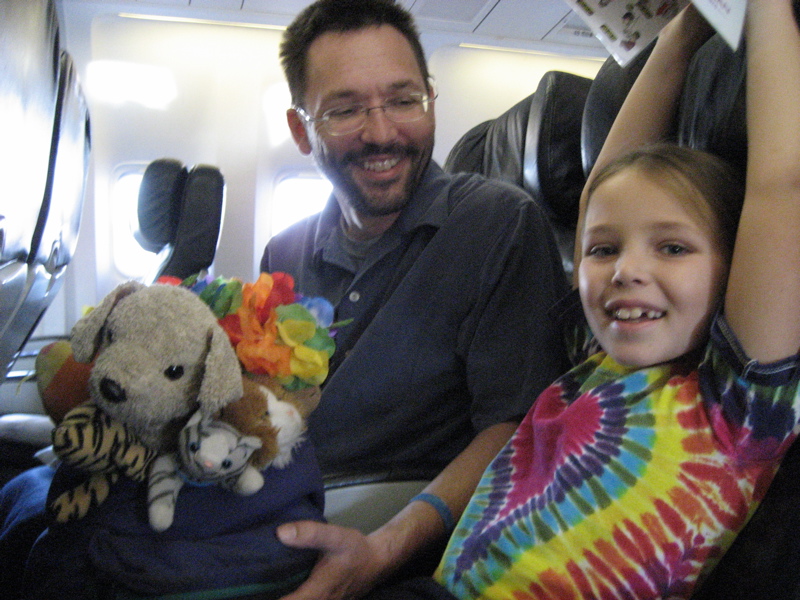
From observing the other passengers on the plane, I see two common responses to the lack of space in a jet airliner. Most people withdraw like a turtle and try not to notice the outside world, even when the guy who bought four gin bottles from the flight attendant is now lurching around inches from their lunch.
Sitting in seat 44G and trying to read a book I have a wide range of body parts thrust into my little space, including a variety of buttocks, the occasional hip, and a pair of orange-striped breasts. I really could have lived without any of those intimate presentations. My sandal-clad foot, when it wanders an inch over the little dividing line that separates my space from the aisle, has narrowly avoiding being stepped on several times. Like other people in the “turtle” category, I have been pretending those things didn’t happen.
The other major response is to redefine the boundaries of the aircraft and simply take over as much space as one wants. This is akin to sharing a bed and hogging the blankets; it works great for the hogger and not so great for the bedmate. We are surrounded by “hogs” here in the cheap seats, and frankly they are having a better time. They lean over the aisle to shout boisterously to their new friends. They grab the backs of seats as they walk with total oblivion, and laugh loudly to each other. They stand in the aisles until the flight attendants ask them for the third time to please sit down. Their personal space is pretty much all of Rows 43 through 45, plus the aisle between G and H, plus the back kitchen when the crew is not serving meals. The turtles around them are cowering.
On a long flight, the airplane forms a sort of community, much like living in an apartment building. There’s the hog couple in 43J/H: she talks so loudly that I pity her neighbors, he’s constantly befuddled but eager to let his traveling companions use his Hawaiian Airlines VISA card for their drinks and movie rentals because he gets points. Together they are a sideshow that is occasionally worth watching.
The turtle family in 41 is just trying to survive the trip with two small children, one of whom periodically shouts something unintelligible to all of the coach section. The baby behind us in 45G starts to cry sympathetically when the baby in 41 does, so we get stereo crying every 20-30 minutes. When the movie ended, the airline began playing scorchingly loud Hawaiian music over the public speakers which didn’t improve anyone’s mood and woke up all the babies.
This flying experience will end, as they all do, with the screech of tires on the runway, everyone standing up to await the jetway, and a huge sense of relief that it’s all over. I see the same look on the faces of people coming off the jetway as I see on people leaving the dentist. At least until they get to the baggage claim and the car rental counter “¦
Still, at the end of the day there is a nice reward. We’re in Hawaii now, and it is beautiful as always, and ahead of us lies a promising range of possibilities. The plane ride will be worth it in the long run. We have no worries except for the slim prospect of our Airstream being burned in a wildfire while we are gone, but I’ll try to concentrate on the snorkeling instead.
November 23, 2007 at 9:31 pm · Filed under Uncategorized
We bid adieu to our courtesy parking hosts, Don and Gail, and hauled the Airstream 100 miles northwest to its storage spot in the hills. On the drive, I reflected on our uncommon success at finding courtesy parking this month in California. One night in Chico, two nights in Amador City, three nights in Visalia, two nights in Los Olivos, two nights in Ventura, and three nights in Riverside. That’s 13 nights in the past month.
Not only did we meet a bunch of really cool new friends (and solidified our relationship with others), but we saved about $300-500 on campgrounds. Courtesy parking is great! Some of the folks who hosted us will visit us in Arizona later, and we’ll cross paths with the others again somewhere on the road.
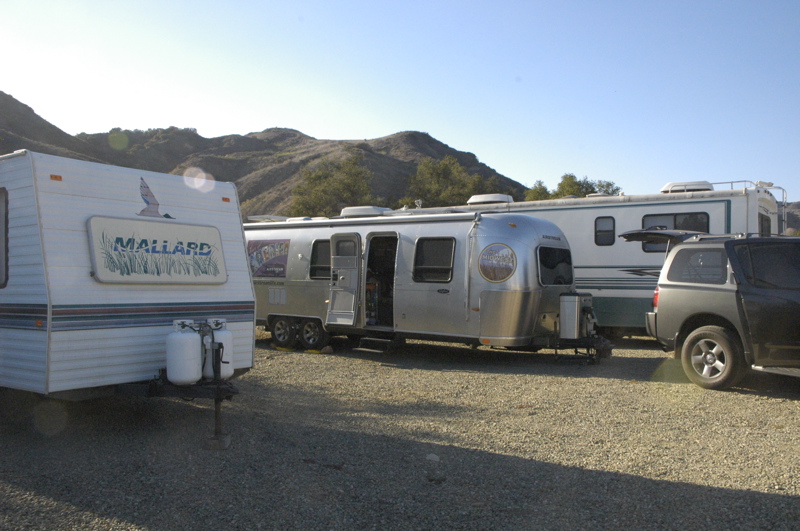 The Airstream is now tucked away in “an undisclosed location” as the Feds would say, with the furnace set at 45 F in the unlikely case of an extended cold snap and several precautions taken to make it very hard to steal. We left the refrigerator running because it is still full of food. The solar panels will keep the battery topped off so there’s no concern about coming back to a dead battery, but there is some small concern about coming back to a dead vegetable, so Eleanor stripped the fridge of virtually everything that could rot and brought it with us.
The Airstream is now tucked away in “an undisclosed location” as the Feds would say, with the furnace set at 45 F in the unlikely case of an extended cold snap and several precautions taken to make it very hard to steal. We left the refrigerator running because it is still full of food. The solar panels will keep the battery topped off so there’s no concern about coming back to a dead battery, but there is some small concern about coming back to a dead vegetable, so Eleanor stripped the fridge of virtually everything that could rot and brought it with us.
From there we drove another 70 miles down to an airport hotel in El Segundo, along the southern edge of Los Angeles International Airport (LAX). Being a former advertising copywriter, I can’t help but notice the opportunities for billboards and slogans offered by the airport’s designator. Here we are, re-LAXing in the spacious comfort of the Embassy Suites (the room offers more than twice the space of our Airstream). It LAXs for nothing; we have a microwave, refrigerator, couch, easy chair, dining room table, two huge flat-panel TVs, and a fine view of two runways at the airport.
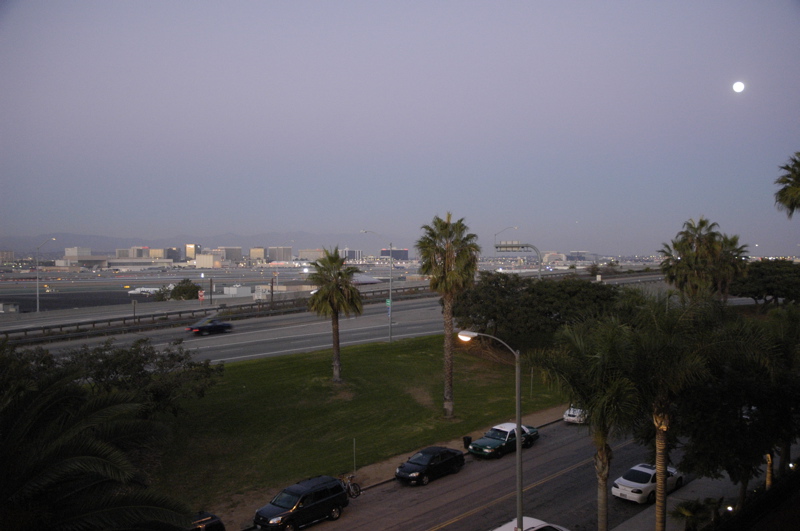
This transition from Airstream to hotel marks the official beginning of our vacation. We haven’t been in a hotel since …. hmmm… I think almost two years ago (January 2006), when we took a night in San Francisco at Fisherman’s Wharf. It’s a neat thing to do once in a while, but I wouldn’t want to make a habit of it. It took Eleanor about six hours to pack for herself and Emma, and the entire Airstream was turned inside-out until late last night. I’ve said it before, but I’ll say again: What a pain it is, packing for a family vacation. I’m glad we don’t have to unpack and repack every time we go somewhere in the Airstream.
Tonight we are feasting on fridge leftovers: a massive salad made of lettuce, mushrooms, tomatoes, artichokes, sesame seeds, cucumber, croutons … Eleanor forgot the shredded cheese, and thankfully left the other items on the side: croissants, grapes, cookies, etc. This is what happened the last time they flew somewhere, except now I’ve got help eating the fridge leftovers. Good thing, because it’s a lot of roughage. Could have a LAXative effect. (Sorry, but I had to write that. It was just too tempting.)
November 22, 2007 at 10:40 pm · Filed under Tips & Ideas
We are very busy now, trying to get ready for our vacation next week, so it’s a good thing we got an invitation to Thanksgiving dinner. Eleanor contributed only gravy, and otherwise we left the cooking to our friends (and found ourselves in very good hands, indeed!)

We are busy because we have a plane to catch on Saturday morning, and before then we need to get the Airstream ready for storage, get ahead on work as much as possible, pack, relocate the Airstream to storage (about 100 miles away), and then get ourselves to LAX.
We’ve done this dance before, so we know the steps. A little networking found us a safe place to store the Airstream, and the process of putting it to bed for a week or two isn’t difficult. The fridge will remain running on propane, and the solar panels will keep the batteries topped up. All the really valuable stuff will be with us (mostly the laptops and cameras), and the trailer will be well cleaned so that critters will not be encouraged to sublet the place. It will be ready to go when we return from our trip.
As always on Thanksgiving, I try to give a few minutes to count blessings, and this year we have many. I’m thankful to still be in business doing something I enjoy and which gives us this interesting lifestyle. We’re all in good health, our future is bright (if not totally assured), and the people we care about are all doing well. There are many things to be concerned about but today is not the day for that. Today is the “glass half full” day.
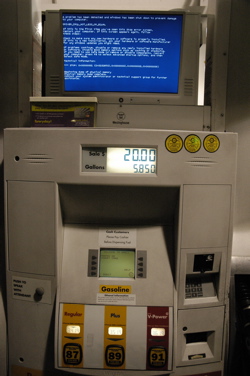 On the way back from dinner tonight we stopped for gas, and I was treated to an increasingly-common phenomenon: an annoying television blasting loud commercials at me about skin cream and bogus ways to make money buying distressed real estate. I’ve encountered this before, but this was the first time I’ve seen one without a “mute” button. (Robert Heinlein foresaw this; I can’t remember if it was in “Podkayne of Mars” or one of his Lazarus Long stories. In the story it was in a taxi cab, and a bribe to the cabbie made the screaming ads go away.)
On the way back from dinner tonight we stopped for gas, and I was treated to an increasingly-common phenomenon: an annoying television blasting loud commercials at me about skin cream and bogus ways to make money buying distressed real estate. I’ve encountered this before, but this was the first time I’ve seen one without a “mute” button. (Robert Heinlein foresaw this; I can’t remember if it was in “Podkayne of Mars” or one of his Lazarus Long stories. In the story it was in a taxi cab, and a bribe to the cabbie made the screaming ads go away.)
 I should have used the adjacent gas pump, where the ad system had crashed. That’s increasingly common too, since these systems are often based on Microsoft Windows. (If you find this amusing, check out Miguel Carrasco’s site.) So here’s the glass-half-full portion: This proves there is a good reason for Windows to exist after all. It gives us a good chance of avoiding obnoxious ads!
I should have used the adjacent gas pump, where the ad system had crashed. That’s increasingly common too, since these systems are often based on Microsoft Windows. (If you find this amusing, check out Miguel Carrasco’s site.) So here’s the glass-half-full portion: This proves there is a good reason for Windows to exist after all. It gives us a good chance of avoiding obnoxious ads!
Happy Thanksgiving to all.
November 21, 2007 at 11:35 pm · Filed under Uncategorized
The overriding factor that seems to govern the lives of people in all of the Los Angeles area, including far-flung portions like Riverside and San Bernardino, is traffic. On the freeway, timing is everything. If you hit it right you zoom along at 65 MPH or better, and if you venture onto the freeway at the wrong time, heaven help you because you may be like Charlie on the MTA (Cue the Kingston Trio: “He never returned, no, he never returned, and his fate will never be learned …”)With this in mind we have traveled cautiously these past 24 hours. Friends of ours were staying at the downtown Marriott and we tip-toed through the traffic this morning to meet them for a really great brunch. So far, so good.
Then my task was to drive 15 miles down “the 91” (as they say around here) to Corona, to meet up with Andy Rogozinski, the proprietor of Inland RV. He’s the guy who virtually invented the Airstream vintage parts business. He’s been in the Airstream community for over 40 years, starting off as a dealer service tech, moving up to Caravanner Insurance in 1970, and now selling vintage Airstream parts out of his facility in Corona. Almost everyone who has ever done a vintage Airstream restoration has dealt with Andy at some point.
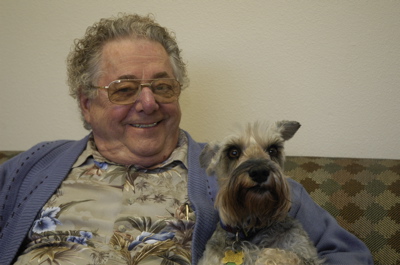
Traffic will be particularly of interest to us on Friday. We’ll have to tow the Airstream back 100 miles to storage, then drive about 30 miles to LAX. I’m crossing my fingers that Friday is a light traffic day all over Los Angeles.
The Santa Ana winds are forecast to being to blow soon. This will have two effects: It will clear the smoggy air and give us a decent view, and it will fan any flames if a new set of wildfires break out. After seeing what happened a few weeks ago, everyone here has gained respect for the power of fire and wind. And of course, it can’t possibly be good for traffic.
« Previous entries ·
Next entries »
 Our initial impression was that these were beach bums, drop-outs, and surfers who were only taking advantage of a cheap lifestyle, but upon a closer look it has become clear that families are living there. There are children and old people, people who live in dirty clothes and a few who drive expensive cars.
Our initial impression was that these were beach bums, drop-outs, and surfers who were only taking advantage of a cheap lifestyle, but upon a closer look it has become clear that families are living there. There are children and old people, people who live in dirty clothes and a few who drive expensive cars. Our final lesson on Hawaii comes from the food. Go to a lu’au and you’ll get some traditional Hawaiian foods like poi, and a lot of other modern favorites like pork ribs. In the fancier restaurants you’ll find “Asian fusion” and “Pacific Rim” cuisine. But today’s Hawaii has a people’s cuisine that the fancy resorts won’t acknowledge. Here on the cheap side of the island there are several “chop suey” restaurants, and in our quest we felt obligated to give them a try. Clearly they are popular with the locals.
Our final lesson on Hawaii comes from the food. Go to a lu’au and you’ll get some traditional Hawaiian foods like poi, and a lot of other modern favorites like pork ribs. In the fancier restaurants you’ll find “Asian fusion” and “Pacific Rim” cuisine. But today’s Hawaii has a people’s cuisine that the fancy resorts won’t acknowledge. Here on the cheap side of the island there are several “chop suey” restaurants, and in our quest we felt obligated to give them a try. Clearly they are popular with the locals.

















